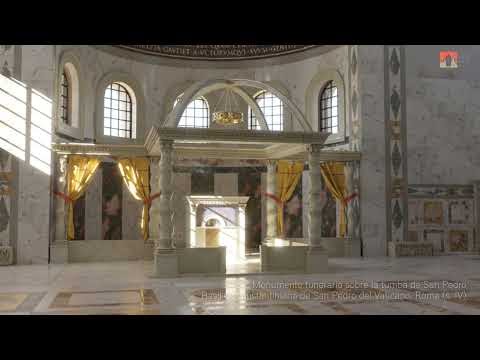- Feb 5, 2002
- 166,626
- 56,258
- Country
- United States
- Faith
- Catholic
- Marital Status
- Married
- Politics
- US-Others
We are very grateful to Prof. Pablo Aparicio Resco for his kind permission to reproduce these images of a very interesting project he has been working on, a virtual reconstruction of the ancient basilica of St Peter. (Video and images from PAR – Arqueología y Patrimonio Virtual and 3D Stoa – Patrimonio y Tecnología.)
As I am sure our readers already know, the original building was constructed by the Emperor Constantine in the earliest days of the Peace of the Church; the traditional date of its consecration is November 18, 326. By the mid-15th century, it was over 11 centuries old, and in very poor condition, as was much of Rome after the neglect entailed by the long papal residence in Avignon (1309-76), and the events of the Great Schism (1378-1417). In the 1440s, the Florentine scholar León Battista Alberti (1404-72) was serving as architectural advisor to Pope Nicholas V (1447-55), and pointed out to him that a stretch of the north wall (on the right as one looks at the façade) totaling about half its length was sagging well over three feet off the perpendicular. After various rather half-hearted attempts to restore it, the building was deemed unsalvageable, and in the beginning of the 16th century, the project of replacing it was begun by Pope Julius II (1503-13). Julius’ project, however, stalled repeatedly, and would not really begin in earnest until many years later, when it was assigned to Michelangelo by Pope Paul III in 1545.
The Constantinian basilica was placed so that the apse would enshrine the grave of St Peter, which, however, was in the middle of a very large necropolis on the Vatican Hill. This required not only that a good many burials be disturbed, but also that a massive part of the hill itself be moved, amounting to about a million cubic feet of dirt. As a very good guide once pointed out on a tour of the modern excavations under the new basilica, this alone makes for a very strong argument in favor of the authenticity of the gravesite as that of St Peter. Next to the site was a ready-made flat space formerly occupied by the so-called Circus of Nero (more properly, of Caligula), where the church could have been built more easily. Constantine would be unlikely to expend so much time and energy flattening the hill, unless he needed to do so to include the grave.
This view, therefore, shows us how one would originally have approached the church, walking through the part of the Vatican necropolis that remained undisturbed, (the modern Via della Conciliazione.)
Continued below.

 www.newliturgicalmovement.org
www.newliturgicalmovement.org
As I am sure our readers already know, the original building was constructed by the Emperor Constantine in the earliest days of the Peace of the Church; the traditional date of its consecration is November 18, 326. By the mid-15th century, it was over 11 centuries old, and in very poor condition, as was much of Rome after the neglect entailed by the long papal residence in Avignon (1309-76), and the events of the Great Schism (1378-1417). In the 1440s, the Florentine scholar León Battista Alberti (1404-72) was serving as architectural advisor to Pope Nicholas V (1447-55), and pointed out to him that a stretch of the north wall (on the right as one looks at the façade) totaling about half its length was sagging well over three feet off the perpendicular. After various rather half-hearted attempts to restore it, the building was deemed unsalvageable, and in the beginning of the 16th century, the project of replacing it was begun by Pope Julius II (1503-13). Julius’ project, however, stalled repeatedly, and would not really begin in earnest until many years later, when it was assigned to Michelangelo by Pope Paul III in 1545.
The Constantinian basilica was placed so that the apse would enshrine the grave of St Peter, which, however, was in the middle of a very large necropolis on the Vatican Hill. This required not only that a good many burials be disturbed, but also that a massive part of the hill itself be moved, amounting to about a million cubic feet of dirt. As a very good guide once pointed out on a tour of the modern excavations under the new basilica, this alone makes for a very strong argument in favor of the authenticity of the gravesite as that of St Peter. Next to the site was a ready-made flat space formerly occupied by the so-called Circus of Nero (more properly, of Caligula), where the church could have been built more easily. Constantine would be unlikely to expend so much time and energy flattening the hill, unless he needed to do so to include the grave.
This view, therefore, shows us how one would originally have approached the church, walking through the part of the Vatican necropolis that remained undisturbed, (the modern Via della Conciliazione.)
Continued below.
A Virtual Reconstruction of the Old St Peter’s Basilica
We are very grateful to Prof. Pablo Aparicio Resco for his kind permission to reproduce these images of a very interesting project he has be...
